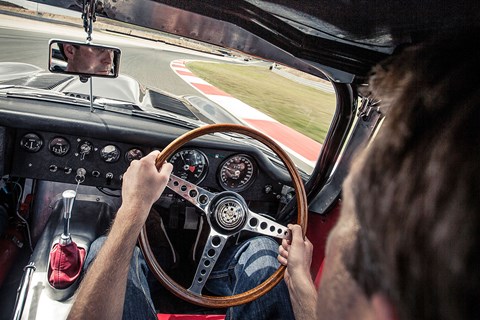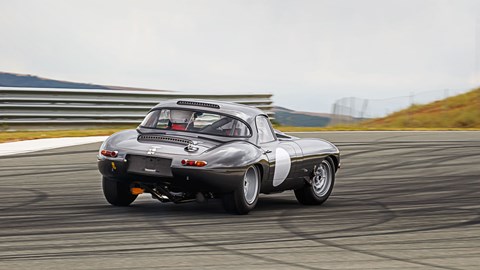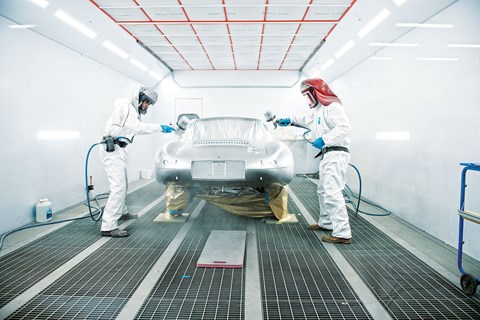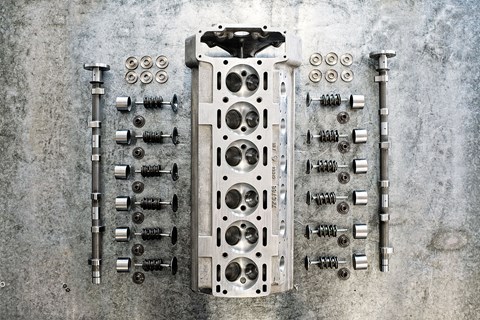► £1million Jaguar E-Type
► Symphony of speed and style
► Lightweight E-Type recreation thrashed
During the 1960s, Jaguar allocated chassis numbers to 18 Lightweight E-types; these cars featured aluminium construction rather than steel, a tweaked engine and extensive chassis mods for racing. The final six were never built, but now, incredibly, Jaguar is dusting off those numbers and finishing the job as close as dammit to original specification.
These new cars weigh a suspiciously even 1000kg, and mate a 335bhp straight-six to a four-speed synchro ’box and slippy diff. There are discs all round, an FIA-approved cage that’ll add more stiffness than the originals ever had, and cross-ply tyres with just as little grip.
Can’t believe it, but I’m driving car number 13 on Circuit de Navarra, Spain. This car is worth over a million pounds and already has a name on the logbook, and the only caveat is that race instructor Andriano Medeiros sits alongside…
I crouch down, climb through the tiny door, buckle up. The cabin is tight – the right roof bar is about an inch from my head – but there’s a friendliness to its cramped proportions that put me at ease: the low-slung seats are snugly comfortable, cool air flows through the ventilated roof, and the cage doesn’t intrude beyond the slim A-pillars, so you immediately feel confident placing that exaggerated nose.
Jaguar E-Type: the drive
The engine wakes with a deep, warm mechanical thrum, and you ease down on the clutch and slot home the thin aluminium shifter; the resistance as you breach the gate like small magnets repelling each other.
At first I’m all nerves, and the fuel-injection and unnecessarily tall gearing for this track doesn’t like it – the Lightweight stutters at low rpms, feels unhappy – but you need time to dial yourself into this driving experience.

You take big sweeps at the steering with its delicate, thin wooden rim. The pedal box – canted to the right – is tight, and the four-speeder has a broad gate; habit means I search for the middle-ground between first and fifth gear, but you just snick the lever far over to the right and be done with it.
I do five laps and fall into easy conversation with Medeiros, chatting about how unhelpful it is to be reminded of a pricey car’s worth. ‘It’s a car,’ he says. ‘You are driving a car.’ If this sounds cavalier, it helps immensely.
The second drive
I go out again, drive harder, and the Lightweight roars and bellows, off the leash and happy. Beyond 3000rpm the engine soars freely and the cabin fills with a mechanical rasp and the whine of gears, each change of ratio inducing an audacious honk of induction. It sounds amazing, and it’s pretty bloody swift too; feels even swifter when you press the brakes.I’d never driven on cross-plys on track before, and I feared that in combination with discs it’d be easy to lock the front tyres. In reality the opposite is true. The non-servoed stoppers are easy to modulate, but the truth is the braking just takes its own course; press as hard as you like and it doesn’t feel like you’ll stop faster. Engine braking is crucial, so you press hard on the brakes, roll your foot over to the throttle to match the revs and slot second, then, yes, first, so tall is this final drive. It’s mildly terrifying, and complicated for me by being a little on the lanky side – I occasionally snag my knee on the steering wheel and catch too much throttle while braking.
Driving within the grip, I wondered if a sliding Lightweight might scare, and when you look at the squat stance and pronounced negative camber on the rear wheels, you wonder if it might be an understeery menace – perhaps it would push on, then snap into flailing oversteer. The E-type will understeer if you’re too greedy on corner-entry, and the tall gearing doesn’t help cancel that, but that’s to misunderstand its nuances.
I get it slowed down, get the front tyres keyed in, and then press the throttle hard; the Lightweight slides out of line, I wind on corrective lock, it straightens, we don’t crash. This split-second reveals the Lightweight to be progressive, a car that gives up its grip gradually and that can be intuitively throttle-steered. Soon I’m going faster, wup-wup-wupping the throttle to make the rear hold its attitude, sometimes catching the wheel rim, sometimes letting it slip through my fingertips like a ship’s wheel in a storm. The booming cabin fills with laughter.
All the intimidation is gone, the value forgotten. The straight-six sings to the redline. I think I spy tyre haze in the rear-view… ‘Okay,’ says Medeiros, giving me a wink. ‘Cool-down lap.’
British cars to drive before you die? Get the bad news and experience one of these, quick.

Recreating the Lightweight: how they did it
To ensure perfect dimensions, Jaguar digitally scanned the left-hand side of a steel-bodied E-type, then flipped the image to create a perfect whole, with one exception: the transmission tunnel was 2mm narrower on the left, so the wider right-hand side was used to ensure mechanical space.
Three design engineers worked 60-hour weeks for 12 weeks generating the surface geometry and tooling assemblies. The ’60s Lightweights were originally built in the same gauge aluminium as the steel cars had used – for safety a thicker gauge was used.
Four people work on the Lightweights at Whitley, where initial assembly is carried out on the same kind of bespoke tooling used to create prototypes of the Jaguar XE, new XF and upcoming F-Pace.

The cars are split into sub-assemblies – the underfloor, bulkhead and rear floor – so the team can construct each independently, then combine the elements to create the sub-structure. The structures are held in place by ‘sacrificial tabs’, which are cut from the aluminium once work is complete. On the final build station, the outer skin, sills and scuttle panel are added. It takes eight weeks to get to this body-in-white stage.
The Lightweights are then moved to Jaguar’s Browns Lane heritage workshops to be mated with the engine and powertrain, before the cars are moved to the paint shop at JLR’s Gaydon engineering base, where they stay for four weeks.

Car six will be complete by the end of the year, and handed over to its owner in February 2016. With Jaguar insisting all are raced, it’s likely they’ll be seen again on track.
The specs
Produced: 1963-’64 and 2014-’16
Price: £1 million
Engine: 3868cc in-line six, 335bhp, 280lb ft
Performance: 3.7sec 0-62mph, 170mph